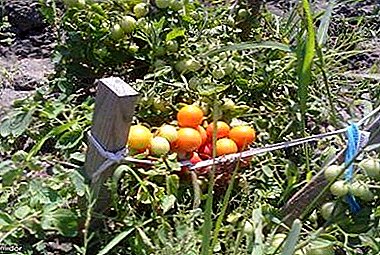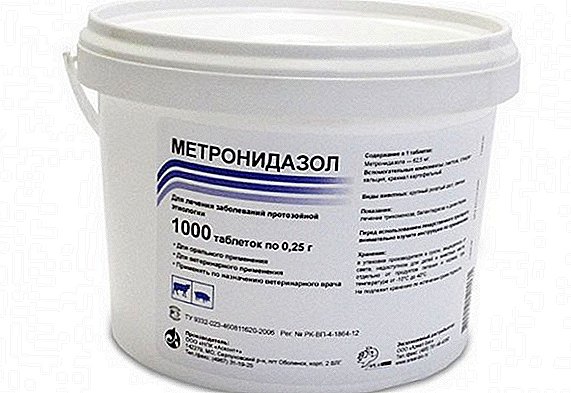 Modern farmers, especially poultry farmers, often face the problem of infecting their wards with various bacterial and parasitic diseases, the development of which is caused by the ingestion of infectious or protozoal agents into the body of birds together with insufficiently processed food or through dirty litter. In this article we will discuss one of the means to effectively and permanently save your wards from such ailments, namely, Metronidazole.
Modern farmers, especially poultry farmers, often face the problem of infecting their wards with various bacterial and parasitic diseases, the development of which is caused by the ingestion of infectious or protozoal agents into the body of birds together with insufficiently processed food or through dirty litter. In this article we will discuss one of the means to effectively and permanently save your wards from such ailments, namely, Metronidazole.
Composition, release form, packaging
The main active component of this drug is an antimicrobial and antiprotozoal substance, bearing the same name metronidazole. In addition to it, it also contains various ballast substances, glucose and chemical compounds, the purpose of which is to facilitate the absorption of the drug and ensure that its greatest amount enters directly into the bloodstream.
Did you know? Homeland "Metronidazole" is France, where it was first synthesized by the company "Rhone-Poulenc" and for a long time was known as "Flagel".
Among the dosage forms in which this drug can be produced, there are a large number of unsuitable for use by poultry, for example: rectal and vaginal suppositories, ointments, toothpastes, etc. Due to the behavioral characteristics of birds, the most acceptable forms of this drug for them are tablets and capsules.  Packaging tablets may vary slightly depending on the manufacturer. Often they are packaged in plastic cans or cardboard boxes of 100, 250, 500 or 1000 pieces each. The mass of the tablet is most often equal to 500 mg, and the amount of the active substance in each of them may be equal to 0.125 or 0.250 g.
Packaging tablets may vary slightly depending on the manufacturer. Often they are packaged in plastic cans or cardboard boxes of 100, 250, 500 or 1000 pieces each. The mass of the tablet is most often equal to 500 mg, and the amount of the active substance in each of them may be equal to 0.125 or 0.250 g.
Pharmacological properties
Once inside the bacteria and protozoa, Metronidazole molecules react with the transport proteins of these organisms, resulting in the activation of a drug that actively binds to the DNA of microorganism cells and blocks the potential for protein synthesis, which makes it impossible for them to replicate further to their doom.
Familiarize yourself with common diseases of chickens and chickens, as well as methods for their prevention and treatment.
The best method of administering this drug is through the gastrointestinal tract.Since, in combination with ballast substances, its absorbability from the intestine is almost 100%. Then Metronidazole is partially metabolized in the liver (its main metabolite has a no less pronounced antimicrobial and antiprotozoal effect), and it is partially distributed throughout all biological fluids of the bird's body, destroying bacteria and protozoa. 
Did you know? "Metronidazole" is included in the list of vital and essential medicines in Russia. This list regulates the prices and availability of the most important medicines throughout the country.
The half-life of the drug is about 8 hours. Most of it leaves the body through renal filtration (60-80%), and the rest is excreted in the feces. Metabolites formed in the liver, excreted from the body a little longer.
From what give
This drug has a tropism (affection) in relation to many protozoal infections, among which it is especially worth highlighting the most common in birds:
- histomoniasis;
- trichomoniasis;
- coccidiosis;
- gardnerellosis;
- various anaerobic infections.
Learn how and how to treat coccidiosis in chickens.
 Coccidiosis in chickens Among the symptoms that can push you to the decision that your chickens need Metronidazole intake, it is worth noting: diarrhea with blood, loss of appetite in birds, an increase in their need for fluid, a decrease in mobility, a desire to lose one flock and be located as close as possible to the heat source, even if the weather is warm outside.
Coccidiosis in chickens Among the symptoms that can push you to the decision that your chickens need Metronidazole intake, it is worth noting: diarrhea with blood, loss of appetite in birds, an increase in their need for fluid, a decrease in mobility, a desire to lose one flock and be located as close as possible to the heat source, even if the weather is warm outside.
How to breed and how much to give chickens
Since the drug best enters the bloodstream through the gastrointestinal tract, the best method of its introduction will be mixing tablets with food. For adequate treatment, you will need to add 1.5 g of Metronidazole for each kilogram of feed you will feed the birds with.
The process of adding tablets to the feed should take place immediately before the start of feeding, since there is a high probability that the pre-added drug will react chemically with the microorganisms in the feed and deactivate. Tablets before adding must be thoroughly crushed in a mortar to a state of powder.
You will probably be interested to learn how to make the right diet for chickens and how to prepare compound feed for birds on your own.
 Dosage for treatment and prophylaxis is not different, because the likelihood that birds are already carriers of an infection that is not yet activated because of the high immune function of the birds or the wrong time of year is very high. The term of prevention is 1 week, treatment - 10 days.
Dosage for treatment and prophylaxis is not different, because the likelihood that birds are already carriers of an infection that is not yet activated because of the high immune function of the birds or the wrong time of year is very high. The term of prevention is 1 week, treatment - 10 days.
Important! Do not try to dilute the powder from the tablets in water, as a result of this, it will simply settle on the bottom and will not bring any therapeutic effect, since it practically does not dissolve in the liquid.
special instructions
"Metronidazole" - a drug with a very short half-lifetherefore, most likely, in the meat of birds that you slaughtered for meat, even after using this medicine, you will not find any traces of it. Nevertheless, it is recommended to wait before slaughter of the birds since the last injection of the drug for at least 3-5 days. It is also impossible to eat eggs that carry chickens during this period, since the preparation is able to penetrate the tissues of the eggs.
This drug has a significant effect on the functioning of the feathery buds, so try not to give it to them for the purpose of prevention too often. It will be enough to 1 course per year, preferably in the winter-spring period.
Contraindications and side effects
When using Metronidazole according to the instructions, the risk of any adverse reactions is extremely small. The most dangerous and frequent type of side effects in chickens are allergic reactions. In addition, during improper or too frequent use of the drug, liver and / or kidney failure may occur, leading to the death of the bird.
Important! If you notice any allergies in birds, you should immediately contact a veterinarian to prescribe a drug of a similar spectrum of action, but with a different chemical composition.
Shelf life and storage conditions
Tablets are best kept in their original containers, out of the reach of sunlight, in a dry place at temperatures from +5 to +20 ° C, preferably away from children and pets. Do not allow the contact of medicines with the surfaces on which the cooking process takes place, as well as the dishes from which people eat. Shelf life if all storage conditions are met - 5 years.
Find out what causes diarrhea in chickens and what to do if chickens fall to their feet.
Manufacturer
It should be noted right away that there is absolutely no point in buying an imported drug, since its chemical structure is absolutely no different from its domestic counterpart, but because of the cost of transportation it costs much more.
Among the domestic producers of "Metronidazole" it is worth noting:
- "Borisov Medical Preparations Plant";
- "Ascont +";
- "Agrovetzashchita".












